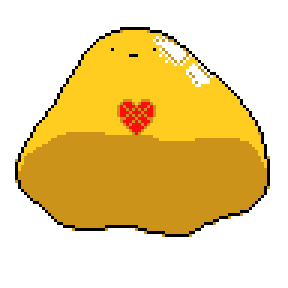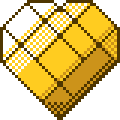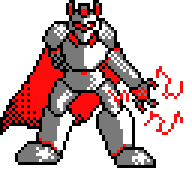Behind the Liminal Pt. 3: Gameplay - The Experience
By far the biggest sub-category I wanted to emphasize this Harold Jam was gameplay. Unlike last Harold Jam where I capitalized on my strengths, I wanted to take a risk and nail down a gameplay loop which could not only sustain a jam game but form a foundation for the full-length Colors of Life. I have the dreams but not the experience to build them, so focusing on gameplay itself was extremely important. What's a game with tons of effort put into its appearance, sound, and story if it's not fun to play?
My goal was to stick to the core ideas the Colors of Life team and I had theorized and pretty much throw all of them at the wall to see what stuck. These included:
- Ability to change colors
- Change elemental type
- Change stats
- Change moveset
- Camouflage when color matches background
- Avoid enemies in the overworld
- Decrease enemy aggression in battle
- Different overworld abilities for party members
- Experimenting with one party member on the field at a time
While it was already a success having all the planned mechanics working together, it didn’t go 100% smoothly. Alongside some explanations and behind the scenes, I’ll also be documenting what I learned from each mechanic and how I could improve it for TCOL.
Changing Colors
Changing your color to affect gameplay in some capacity is the backbone of The Colors of Life. Recall the waking dream where Reid changes his playstyle in a single move and the way it got turned into a chameleon who is also a magical girl (or at least tries to be). This was the mechanic that had to be in Stuck in the Liminal. No backsies.
Over the year and a half I planned TCOL before Ascent of the Allies, I was set on color changing affecting your moveset and elemental type. However, a huge discussion with game making buddies way cooler and smarter than me also introduced the possibility of colors being classes with different stats. I decided to implement all three into Stuck in the Liminal.
Movesets were a pain for me to plan, and in retrospect this is something I should have done way way way earlier. While I wanted Introspect to play almost like competitive Toxapex with stalling and status ailments but hardly any attack moves, I struggled to figure out the others. Thankfully Violet Spinel the battle system god drafted his own movesets which I ended up using. Wish I had picked his brain about his choices a little more (albeit it’s never too late for that) but he knows way more about this than I do so I think it worked out.
While I designed the color changing system for seven colors including white, Stuck in the Liminal only included four to reduce scope. While this was pivotal to the game getting done at all, it may have also led to the battle system feeling lopsided despite every color having equal buffs and nerfs. Human, the organizer of Harold Jam, managed to steamroll the game by turning red and using Tackle to deal increased white damage with no regard for enemy weaknesses.
Improvements
The lesson to be learned here is not to go back and remove elements, but to rework and improve them. It’s hard stuff, but I still see tons of potential in this system and my sentiments have been shared by quite a few other people. With that said, to exploit flaws in this way is to prove what a prototype would set out to do, so this is actually a win in my book. What matters is using this result to prototype new approaches and have them thoroughly tested by other players, hopefully without a jam deadline.
Additionally, color changing is a lot to take in especially for a jam game. In a full-length game, I’d probably spend a whole Stuck in the Liminal explaining the color system just so the player wouldn’t end up confused down the road. What I really should’ve done was include a matchup chart somewhere. Violet Spinel’s Rage Against the Dying embedded one in the battle background which is super easy to do. It set in a few weeks after voting started and I’m still kicking myself for not doing that.
Balance is also key when so many elements are on the table. Should I include both elemental types and stat changes for each colors, I’d ideally want to weigh one far more than the other. Spoiler alert; we’re gonna find out in about a week that most players valued elemental types more than stat changes. In this case, when I go for my full seven-color battle system, I may have each color boost and nerf one stat each but create a well-defined elemental type with many different strengths and weaknesses.
Camouflage
I don’t care if Reid is a human and not a chameleon; he had to find some way to camouflage in SITL for it to truly be a TCOL prototype. This was a classic example of gameplay taking precedence over story, as my reasoning for Reid being able to camouflage was rushed and glossed over. Implementing camouflage was simple enough, as Yanfly came to the rescue with their Event Chase Stealth plugin. I added a few aesthetic changes, sound effects, and a failsafe if using another party member, but everything else was vanilla. I wanted to implement a cooldown for camouflage, but time got the best of me and it didn’t change much in the end. Turns out not a lot of people thought the game needed a camo cooldown, so hey.
While camouflaging to prevent enemies from noticing you in the overworld and in battle was planned, using it to find Facets was not! I completely improvised this bit to take further advantage of the camouflage mechanic. I’d call it a half win; the idea was cool but having to keep going in and out of camouflage and remembering where all the Facets were was a common gripe among playtesters. I could argue about how it opens up some sort of memory game element, but I don’t know.
Improvements
The obvious one here is I really didn't do much with the camouflage system, nor did I design maps or enemies in a way that would really make it shine. This led to it being the most divisive mechanic in the game so far. The goal here is to revisit the Event Chase Stealth plugin (assuming I even use RPG Maker MV for TCOL) and really get to know how it works. I'll also need to look into games that utilize stealth in some way since I'm not super familiar with stealth mechanics myself. One friend suggested camouflage trigger enemy encounters if the enemy is looking right at you up close so there would still be some inherent risk even when camouflaged.
I’d also like to try having hidden items be obtainable in camouflage instead of outside to make things a little smoother. It also wouldn’t be as core to the gameplay loop as it is in SITL, although it would be a fun feature for optional items and the occasional dungeon gimmick. It would almost feel like an alternate dimension, which is a concept I feel can go far and could potentially be way more enjoyable than what ended up in SITL.
The Detection Dilemma
A fitting way to describe the process of configuring enemy detection is nightmarish. I used Yanfly Event Chase Player in my first prototype to have enemies notice and chase you, but I found out chasing could be pretty jank. I figured this would be especially so in the Liminal’s narrow corridors, so I instead decided to have enemies stop when noticing you and immediately initiate the battle.
To bypass this was an absolute warhellride though, as Event Chase Player and enemy move routes hardly worked early on. I even said F you to Event Chase Player and tried to manually create my own detection system using another plugin to expand an enemy’s touch radius. This obviously did not pan out. I also found out the hard way Event Chase Player would only work in an autonomous move route applied to an event page instead of specified through a command. I finally realized the power of using switches to change event pages with different move routes and using Event Chase Player to trigger a common event upon detection, but RPG Maker still had tricks up its sleeve. I originally had the common event change a self switch for the current event, but that proved to be useless. I then tried a universal Notice switch instead, but this made every enemy stop and notice you! My final solution was to trigger one of three common events that would turn on a different Notice switch so it would only affect the current enemy. From there, I would have the enemy detection events set in a new page when the switch is enabled. Each enemy would need a different common event in the move route and a different Notice switch in the event page. And finally enemy detection relented.
Confusing to read? Imagine how it felt making that. Honest to god I’m pretty sure I had a brain aneurysm. The front of my head was in agonizing pain and felt like it was about to explode. I was so mentally shot I could not formulate thoughts and turn them into words. At the end of the day though, I think it turned out well enough. The true blessing was it was done after that; every other enemy was copied and pasted and the only challenge was ensuring they all had unique Notice switches.
Improvements
While there isn’t a ton to say about how to improve this for a full-length game, ideally I would want to give normal enemy chasing mechanics another shot. If I still use RPG Maker MV, I would like to experiment with the Yanfly plugins a little more to see if I could improve detection and chase handling.
Enemies
Enemies were tough to figure out, but I wanted them to play off the battle system. Whether I truly achieved that or not is up for debate.
I wanted the Technicolor Slime to parallel the first battle in Stuck in the Past and really hammer in the battle system first thing. It proved to be a little confusing for players though, so I saved it until after the first few slimes.

Cores were intended to be a subversion of the usual type matchup system, but they did lead to some confusion. Making enemy weaknesses and resistances easy to understand is paramount for a finished product.

Fakets were an idea I had while zoning out at work thinking about Gimmighoul and mimic enemies. The name came naturally. Conceptually they’re clones of the Blurgs from Stuck in the Past.

It took a while for me to think up a strong enemy, but the idea of souls of travelers who had died in the Liminal was too good to pass up. While I thought I had perfected Souls as stronger enemies, I really should have made them immune to White moves to really spice things up. Would’ve made the game a bit less of a Tackle spamfest.

Guardians were originally an excuse to have the player level up and see the new moves they learned when ascending to a new floor. They ended up becoming Tera type Pokemon which I'm more than okay with. I intended for more gimmicks than their armor breaking mid-battle but couldn’t figure any out in time.

Improvements
Enemies having even slightly different weaknesses throughout proved to be a detriment. While I thought I explained Cores well enough, in the context of a brief jam game they tripped plenty of players up. At the same time, though, having a seven-element system where every enemy has the exact same weaknesses would get old very very fast. I’d ideally handle it like a more conventional JRPG where different enemies have different weaknesses regardless of their color and the rock-paper-scissors color matchups would be reserved for party members. I’ve also thought about handling it like Octopath Traveler or Persona and letting the player experiment with different enemy weaknesses to unlock a weakness indicator that would display for the enemy from that point forward.
Button Mashing Blues
The Aspect and party switching mechanics came a long way. My original method for switching was a key command that brought up a menu much like the one that pops up when interacting with a torch. When I rolled out the first alpha build, it was Nateplays95 who suggested I try having the key command automatically go to the next Aspect or party member to save time. I managed to get it working quick enough and it made a world of difference. I almost ran with it before a late beta test run by Violet led to some words that still live in my head rent free.
> A lot of that time was wasted just wrestling with the game being kinda annoying about what you're allowed to do when.
> I don't think the restrictions are necessarily bad but it'd be a lot more efficient and enjoyable if the game just auto-swapped instead. Like, when I press C, instead of yelling at me for forgetting to switch colours, just switch my colour to the right one or something haha. When I press a next to the water, just auto switch me to Alex. Little things like that
What I had essentially implemented this whole time was a bunch of extra button presses that added nothing to the player’s actual decision making. I’m not sure how I didn’t realize this earlier, especially since even I got frustrated and confused with switching Aspects and party members at times. I wasn’t sure how long it would take to implement automatic switching so I considered it a low priority. On the last day of the jam, though, I decided to bite the bullet and it made a world of difference. Honestly the biggest takeaway here is for me to know if a certain mechanic feels odd and make the effort to change it to be better in the long run.
Improvements
I’m not sure what this means for the actual Colors of Life, since it can be interpreted in many different ways. Should camouflaging not be dependent on your current color even if it sacrifices logic? Would it be a good idea to automatically switch color when camouflaging and switch back afterward? Would party switching even matter if the entire party is onscreen like a conventional RPG? Implementation is just as important as ideas.
Up next, The Cast of Stuck in the Liminal and their multi-faceted personalities and origins!
Get Stuck In The Liminal
Stuck In The Liminal
The sequel to Stuck In The Past!
| Status | Released |
| Author | callmeDJ |
| Genre | Role Playing |
More posts
- Beyond the Liminal Pt. 3: The Final ResultsJun 01, 2023
- V1.0.1May 18, 2023
- Beyond the Liminal Pt. 2: The Postmortem and ConclusionMay 07, 2023
- Definitive Edition!May 07, 2023
- Beyond the Liminal Pt. 1: The AnalysisApr 29, 2023
- Behind the Liminal Pt. 8: Lost Souls - The Cutting Room FloorApr 26, 2023
- Behind the Liminal Pt. 7: Overall - The JourneyApr 25, 2023
- Behind the Liminal Pt. 6: Music - The Sound and ScoreApr 25, 2023
- Behind the Liminal Pt. 5: Graphics - The Art CollectiveApr 24, 2023
- Behind the Liminal Pt. 4: Comedy - The CastApr 23, 2023
Leave a comment
Log in with itch.io to leave a comment.